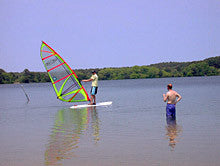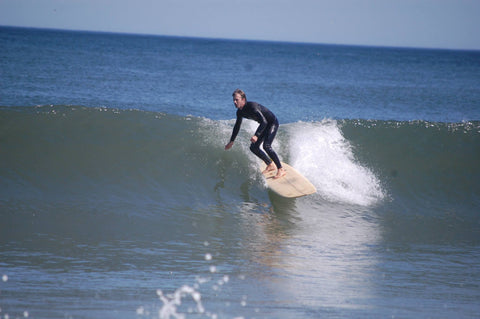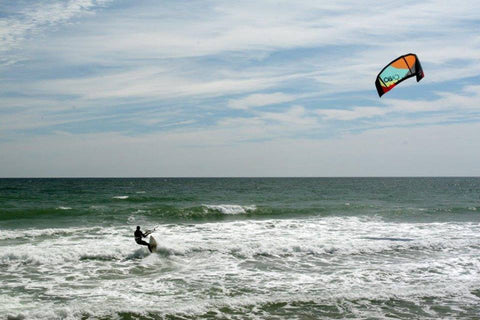
Breezing along
By Stephanie Bergeron
Cape Cod Times
July 2, 2006
The Bible says that Jesus walked on water. I prefer to glide.
On a warm June afternoon, I conquered physics as I windsurfed atop the glistening waters of Gull Pond in Wellfleet.
My two-hour lesson was with Eric Gustafson, owner of Fun Seekers, a Wellfleet-based company specializing in surfing, windsurfing, kiteboarding and kayaking.
After a brief land lesson on wind direction and surfing posture, I headed into the cold water and onto the board. Windsurfing boards are very buoyant, so getting on top of them isn't much of a problem. Once standing fully upright, however, balancing becomes a little more difficult.
Gustafson warned me that I would probably forget that I had to keep my butt in and shoulders back when balancing on the board. He also said that like most beginners I would probably confuse the front of the board with the back and turn the wrong way or forget which way was upwind and which was down. There is no left or right on the water, only a front and a back. Despite these warnings, I was confident that I was better than most beginners.
Slowly, I gained control of my balance and up hauled, or pulled the sail out of the water. The sail is not very heavy, but the real challenge is not falling backward when pulling it up. Luckily, my balance kept me on the board. Once in position, a gentle wind pushed me away from shore as I maneuvered my first turn.
Before taking my lesson I researched windsurfing online. Bright-colored photographs and videos showed professional surfers jumping over waves and sailing effortlessly around sharp turns. My first turn was more like a crawl than a jump.
Like in sailing, there are two types of turns in windsurfing. Tacking is a series of tacks that allows the board to go up wind. Jibing is a downwind turn where the sail passes over the bow of the board.
Unlike windsurfing races, where someone can make a 180-degree turn in seconds, my turn took about four minutes. Still, I managed to turn directions and keep my hair dry. Gustafson said this was an accomplishment.
After a shaky turn, I returned to sailing position. The wind sent me back toward shore and Gustafson told me to turn around. Distracted by the fast approaching shoreline, I forgot about my posture, started turning the wrong way and sent my sail into a dizzying spiral. With my rear out and my back forward, I crashed into the water. My hair was wet. So much for confidence.
Windsurfing speeds depend on many factors. The direction, angle, and size of the sail can cause a surfer to go faster. The bigger the sail, the faster the ride. Beginning windsurfers start with smaller sails. A more stiff and light board will also make the ride faster, and with wind direction, the fastest ride will be a board reach, or 45 degrees off the wind.
Sheeting out, or pushing your back hand away from you, will make you slow down. Sheeting in, or pulling in your back hand, makes you go faster. As for stopping, I chose the little known option of shaking back and forth until I slid off the board in an ungraceful backward belly flop. My hair was wet again.
People who are uncomfortable in deep water or inexperienced swimmers should not try windsurfing. Gustafson does not advocate using a life vest because it can cause someone to become trapped under the board or hit their head if they fall wrong.
Before my lesson, I had never set foot on a surfboard, been in a sailboat or even stood on water skis. After only two hours of instruction, I was windsurfing across the pond. I didn't exactly part the Red Sea like Moses or do anything else of biblical proportions, but the feeling of gliding across the water with a surf board and sail was still mystical for me.


